![]()
Numbers 1 to 17 Long Acre
Introduction
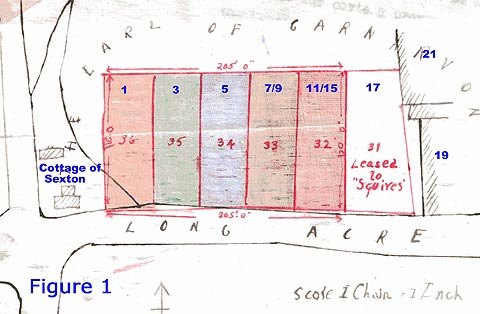
In 1885 The builder James Walker leased five plots of land from The Earl of Carnarvon to build three detached villas (numbers1, 3, 5) and two pairs of semi-detached villas, numbers 7/9 and 11/15 Long Acre (figure 1). The plots were numbered 32 to 36 from the east. Plot 31 had already been leased to Stephen Squires. Walker operated from a yard at what is now Walkers Close further east along Long Acre. He built a large number of similarly aesthetically pleasing houses in Bingham between then and about 1910. We suspect that, in common with many local builders of the time, he worked mostly from pattern books but, disappointingly, we have so far come across very little information about Walker or his business or indeed any pattern books.
The original lease document is with the bundle of deeds for number 1, Cambridge House, probably because it was the last to be built and Walker would have needed to retain evidence of title until that was completed and sold. However, the deed bundle for number 1 also contains an agreement dated 6th October 1888 whereby Joseph Morris (who owned numbers 1-15) acknowledged the right of Mr Cambridge to request Morris to produce the indenture of lease on demand. Does this mean Morris’s houses were the last to be built or did Walker merely pass the lease to the first purchaser? And if so, how did the lease document get from Morris’s possession to the deed bundle for number 1. We shall never know! The dates of the assignment of the leases, whereby Walker sold on the properties to their various purchasers on completion suggest that the houses were built sequentially from east to west, numbers 7-15 being sold on 4th January 1886 and number 1 on 1st October 1888. Number 3, Victoria Villa carries a date stone over the doorway of 1888. But leases of land sometimes were concluded only after the houses had been constructed, so it is not an infallible guide (see below). It is possible tenants were already in occupation, often implied in the documents, paying rent to Walker, before he sold them on.
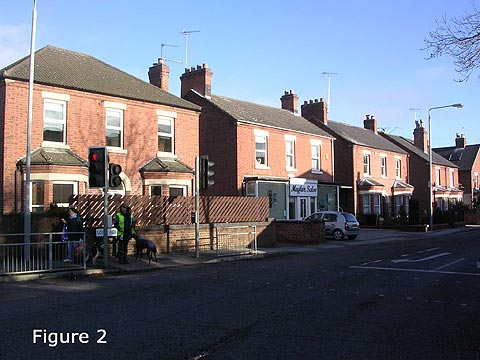
The row of houses (figure 2) comprise a range of ‘Victorian style’ villas along the main thoroughfare at the edge of Bingham town centre. They are solid well built houses with attractive bay windows, stone window lintels (figure 3)
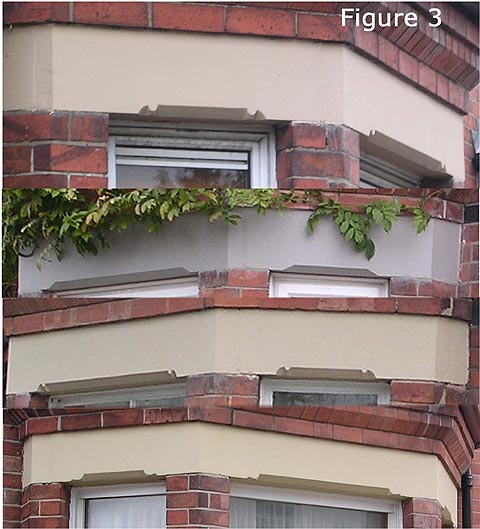
of a variety of subtly different patterns, differently patterned brickwork and doorway treatments. The two pairs of semi-detached villas are of quite different orientation and outward design. All these observations add weight to the argument that the houses were built at (short) intervals and therefore materials would have been purchased at different times. It may also have been a deliberate attempt at style variation to create an interesting and aesthetically pleasing variation in design of the row. The semis have blue brick decoration to the smooth red brick facades.
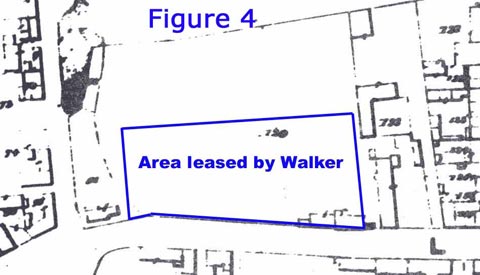
The 1841 tithe award map (figure 4) shows a possible building fronting onto Long Acre on what became plot 31. We have no idea what this might have been although we strongly suspect it was eventually used by Squires’ as a workshop.The 1883 map (figure 5) shows the plot to have been orchards, possibly Bingham’s most famous produce – Victoria Plums. The cottage west of the plots and alongside Fairfield Street was occupied from around 1900 by the Bingham sextant (graveyard keeper) Edmund Derry Smith (from whose name is derived the name of the house numbered 2 Fairfield Street ‘Edmunderry’). That plot was larger then and the front gardens of the row of houses were longer; in 1968 a compulsory purchase order was issued to permit the widening of Fairfield Street and Long Acre.
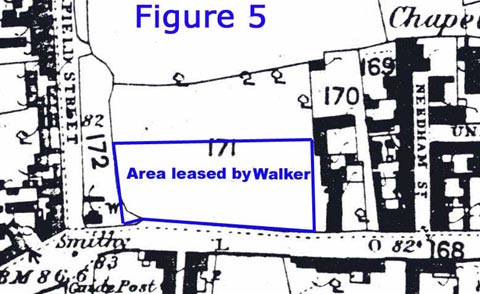
The row of houses is shown on the 1901 map (figure 6) together with the garden pumps to supply water (shown ‘P’).
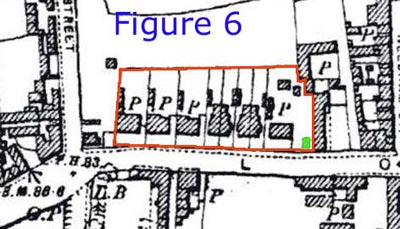
Occupants of all the houses can be traced in the census returns of 1891 and 1901, annotated here to show where we think the each lived.
The original lease document
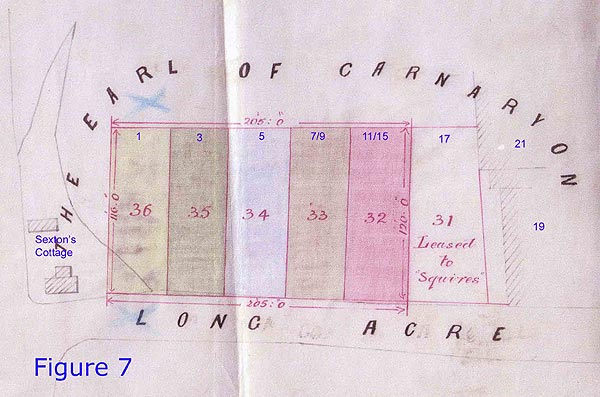
Dated 15 August 1885, this document records that James Walker leased plots 32 to 36 for a term of 95 years. On expiry of the lease the land and buildings would revert to the ownership of the Earl of Carnarvon’s estate. A plan (figure 7) was attached showing each plot. The rental for each plot was to be nil for the first year, £1-10-0 (£1.50) for the second year and £3-0-0 per annum for the remainder of the term.
The lease contains a number of clauses which amount in modern parlance to planning conditions – the earl seems to have been his own town planning officer! The houses and plots had to be well maintained, no alterations were permitted to the elevations without the permission of the earl nor were any additional outbuildings to be erected. The exteriors were to be painted every four years and interiors every seven years. The lease also forbad use of any of the premises as a factory, workshop (presumably Squires’ lease specifically allowed this), public house, club house, beer house, the sale of alcoholic liquor or any ‘noisome, noxious, noisy or offensive trade or business whatsoever. Each house was to be insured for a minimum of £175, which was a curious way of setting the minimum quality of the structures.
We have seen these conditions on other Carnarvon leases.
1 Long Acre - Cambridge House
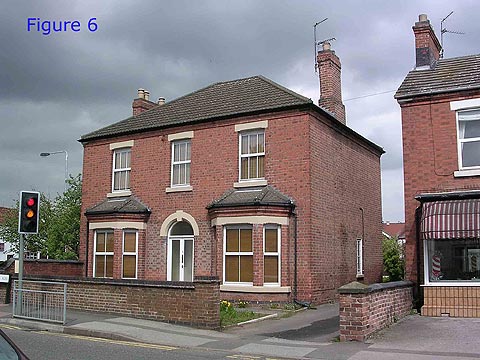
On 1 October 1888 Walker assigned the lease for plot 36 to Mr Frederick Cambridge, organist, of 1 Upper Combe Street, Croydon, Surrey for a consideration of £300. It is this lease that confirms Walker as the builder, as the wording is:
‘sell said piece of land together with the messuage and premises recently erected thereon by the said James Walker…’
The assignment also records that the property was bounded to the east by property owned by William Palethorpe. This was Victoria Villa and may support our assumption about the sequence of building.
The lease also notes that the house was already in the occupation of Samuel Hall, who then became Cambridge’s tenant. The 1891 census reveals that he was aged 65 and living on his own means. His wife, Emma, was 45. Two children also lived there – Adelaide M, 20, a governess and Frederick H, 15 an apprentice ironmonger. Samuel was born in Stansborough (Derbyshire) and Emma in South Runcton, Norfolk; the children were born in Bingham. As with most other middle class families of the period they had a domestic servant, a 15 year old girl called Mary Otter.
In the 1871 census return Hall was described as a wine merchant and ran the Vaults Hotel (although we do not know if it carried that name at that time), more recently the post office house at the corner of Long Acre and Market Street (see Market Street). At that time he was married to Virginia (born in Chelsea) who was aged 37 and they had three children, Albert S, (born 1863 in Wirksworth, Derbyshire), Agnes E, 1866, and Adelaide M, 1870, (both born in Bingham). His sister lived in as governess. Virginia is buried in Bingham Churchyard (NE66 – see churchyard pages ), alongside two more of their children. None of the memorial fragments carries a date.
In the 1881 census Samuel was still at the Vaults Hotel but married now to Emma with Albert L (his son by Virginia,) and also Frederic H (aged 5) and Gertrude A (2) who may have been by either of the wives; we cannot tell from the census and have not yet studied the baptism records for Bingham!
The trade directories for 1869, 1879 and 1881 describe Hall as a wholesale wine & spirit merchant, dealer in ale porter and cigars (with an outlet also in Car Colston). The directories from 1893 and 1896 list him as an insurance agent at Cambridge House, to which he had presumably retired. If the 1893 entry is correct it means the house was built before the lease was signed for the land - which could happen, if a prior agreement had been signed (see 9 Newgate Street). This would challenge our assumption of the sequence of building.
On 5 January 1904 Cambridge sold the house to Mrs Gertrude Alice Shimeld, wife of James Edward Shimeld for £300, the same as he had paid for it, so no inflation in those days! James Edward was Assistant Secretary to the University College, Nottingham, and is recorded as an ‘assistant secretary’ in the 1901 census, at which time he was single and boarded with his brother, Arthur, who was a printer. They were in the Market Place, next door to their father, James, who was a printer, bookseller, stationer and the village post master with a telegraph office. James snr was also Registrar of marriages (Arthur was his deputy). Gertrude A, daughter of Samuel, Hall is not mentioned in the 1891 or 1901 census for Bingham; if she had survived by 1904 she would have been aged 22. James Edward Shimeld, in 1908 and by now aged 39, is shown at Cambridge House in the 1908 directory with a wife named Gertrude Alice. Is it possible that he had married Gertrude Hall, which could explain why the house was sold to her, as the daughter of the house, although there is no note of her in 1891 when she would have been 12? She could just have been away on census night, at boarding school even?
On 11 October 1919 Gertrude sold the house to John H Brown for £475, she having moved to Woodthorpe, Arnold. Brown was noted as already in occupation and described as a retired farmer. He had been bailiff at Starnhill Farm, working for his brother who, in 1901 was described as grocer and farmer. The Browns were of the local grocery firm Hardstaff and Brown with shops on the corner of Market Street and Union Street (latterly Beaumont’s, now Sainsbury’s) and 13 Market Place (on the corner with Moor Lane)
On April 13th 1920 The Earl of Carnarvon sold the freehold to John Brown. The Earl sold very many freeholds in Bingham in 1920; we think to help fund his sponsorship of Howard Carter’s excavation of Tutankhamen’s tomb in Egypt. In 1914 Brown had extended the property by renting an orchard from the Earl. This freehold too was sold to Brown. He paid £75 for the main house and garden and £18-7-0 for the additional piece. As usual the Earl reserved the Mineral Rights. We think John Henry was the uncle of Edwin Brown who at this time owned the two pairs of semi detached villas numbers 7/9 and 11/15.
A letting agreement shows that John Brown moved out of the house. This was dated 11 January 1934 and was with Edward Thomas Hird, of The Bungalow, Fairfield Street. It shows John Henry Brown as living in Newgate Street. We know nothing of Mr Hird.
John H Brown died in 1936 and the house was sold by his executors (his cousin Robert Francis Brown and a friend Henry Tebb). Robert Francis lived at Cromwell House and was a lace manufacturer. Mr and Mrs Herbert Simons were the purchasers for £620; they lived at 8 Long Acre. Described in those deeds as an insurance agent, he was also the agent for the Conservative Party Agent for Newark and Organist at Whatton Church. It is not clear whether they (or Cowdell, see below) lived here or rented it out.
On 3rd February 1949 the Simons sold to Mr L Cowdell of East Street for £2600. According to the directory he was a market gardener and haulage contractor. On 1st October he sold to Mrs N Hitchcock for £2600. Mr and Mrs Hitchcock lived here until 17 April 2002.
There are several other double fronted Walker villas in the town, including Westholme, Eastville, Northleigh, and Hawthorne Villa. Cambridge House is notable in having many features preserved. It has had no extensions. There is the original outside wash house complete with furnace, copper and lid, stone sink and pump. The reception rooms and all three bedrooms have original cast iron fireplaces; the fourth bedroom was, as one would expect, converted to a bathroom. There is a step down pantry with brick vaulted thralls, a typical feature of the other villas, though mostly now extended into by the reception room. There is an attractive Minton tiled hall floor (figure 9), a feature of several other houses in Bingham including some of the other Walker villas.
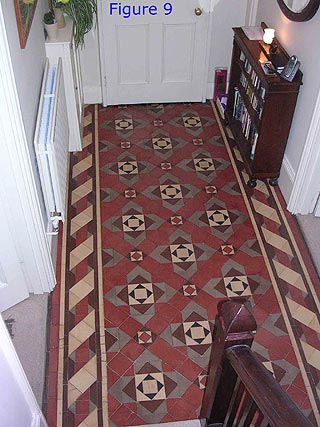
3 Long Acre - Victoria Villa
There is a date stone for 1888 above the doorway and another for 1886 as a gateway capping stone on the wall, but this is almost certainly not in its original position so one ha to doubt its provenance in respect of Victoria Villa. The first conveyance for Cambridge House noted that the next door property was owned by William Palethorpe. He was the chemist and druggist in Market Street and so presumably had bought the house as an investment - and for his retirement.
We know from the census and gravestone information that in 1891 Victoria Villa was occupied by Mary Hutchinson, aged 82, and her son Thomas, 52 a retired farmer. The Hutchinsons had farmed Starnhill for many years, but by 1891 it was in the possession of the Browns. The changeover presumably occurred on the death of Mary’s husband, John (NE061 in the churchyard). Mary’s gravestone (NE060) is inscribed ‘... of Starnhill and died at Victoria Villas...’. The 1891 census confirms they lived next door to the Halls. In keeping with their Edwardian middle class status they too had a servant.
But the 1901 census shows Palethorpe and his wife Jane as next door to the Hutchinsons and with two grandchildren living with them; Edith and Winifred Pell (aged 8 and 5). He is described as a retired chemist. His business premises remained a chemist’s until the late 1980’s. Were the Palethorpes in Gordon House or had the Hutchinson’s moved next door?
15 Long Acre - Alma Villa
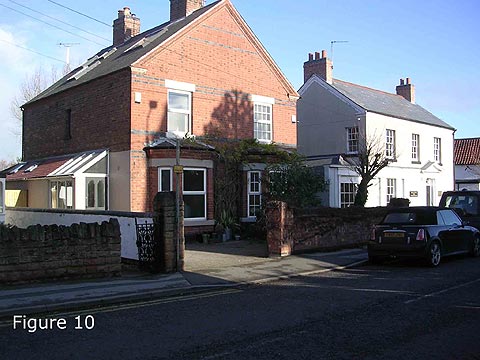
The original lease documents are with number 1 and there are no conveyance documents in the papers for number 15 before an abstract of title of Edwin Brown drawn up in 1920, which gives a synopsis of the history of numbers 7/9 and 11/15. They were completed in the first six months of the lease and on 4th January 1886 Walker assigned the lease for the land and ownership of the two pairs of houses to J Morris, draper of Bingham for the sum of £680. The property was described as:
“First all that plot of ground and premises 1stly described… which form two semi-detached messuages or dwellinghouses fronting Long Acre (this is 15) bounded on the
south by Long Acre
east by premises of Stephen Squires
north by premises of Earl of Carnarvon
“And then in occupation of Mssrs Shelton and Wicklean”, presumably as tenants of Walker and then transferred to Mr Morris. (Wicklean may have been the Catherine Wickham noted in the 1891 census)
“Secondly the plot and premises secondly described … two semi detached messuages… bounded
south by Long Acre
west by premises of James Walker - (i.e. plot 34 and not yet built on or disposed of)
east by plot described above (thus this is numbers 7/9)
north by premises of Earl of Carnarvon.
“And one of said messuages was then in occupation of Herbert Morris and the other was…” (here the text runs out at the bottom of the page)! Joseph’s son Herbert who was a photographer as well as following on in his father’s business as a draper and being clerk to the Bingham Gas Company. He was probably responsible for naming his house (the census suggests this would have been number 9) Camera Villa.
“And also the whole of the wall standing on the west side of the second premises except and reserving to James Walker… the right to have and maintain a gate to and on west side of the gate pillar at the end of the said wall immediately adjacent.”
There was also a covenant for Walker to produce the original lease on request - this original is now with the deeds for number 1 – which implies Walker retained the original whilst the remainder if the land was in his possession, and that therefore that he was working his way west.
Joseph Morris is listed in the trade directories from 1853 to 1893 as being in Market Street as, in various combinations, draper, grocer and tea dealer. In 1881 his father lived with Joseph and his second wife Ellen (Hawkridge). At this stage they presumably lived over the shop and maybe the purchase of these four houses was a provision for a retirement income. In 1891 he was living with his daughter Eliza.
The Morris’s seem to be a good example of a family which grew in status and presumably wealth over the nineteenth century. In 1841 William Morris was an agricultural labourer living in Chapel Lane, his son Joseph became a journeyman baker at age 15 (1841) with Samuel Pilgrim in Union Street (now Butlers) and then went to on to join his father as a framework knitter in Market Street (1851) (perhaps using the workshop adjoining the old farmhouse at the rear of what is now Mee’s TV shop). By 1861 he had become a grocer and in 1871 he had transmogrified into a draper with a shop in Market Street. Framework knitting was in decline;, his father had returned to agricultural labouring but he had managed to be upwardly mobile. By 1886 Joseph had made enough to buy the two pairs of semis from James Walker as an investment for rental. His sons clearly continued the upwardly mobile trend - Thomas became an ironmonger in Sheffield after training as a brazier in Bingham and Herbert became a photographer and secretary to the gas Works whilst continuing the family draper business.
In his will dated 18 February 1892 Joseph Morris appointed his sons Thomas and Herbert as executors.
Herbert is in the directories from 1889 to 1904 as variously a draper, photographer and clerk to the Gas Works with premises in Market Street, presumably also inherited from his father. The 1889 directory has him living at Camera Villas, but he seems to have moved by 1892.
Joseph died on 8th December 1893 and left the four houses, now occupied by Mssrs Cook, Downing (a retired police superintendent who previously had lived at what is now the Old Court House and whose son eventually had a butchery business which was the predecessor of Hopkinson’s in the Market Place), Wickham (living on her own means) and Rockley, to his daughter Ellen (married to Wm Clower of Derby) for her to receive rents for rest of her life then to be sold. He had other property and estate not specifically mentioned which were put into trust.
By 1901 Thomas had returned to Bingham to be an ironmonger on Grantham Road.
On 10th September 1920 Ellen Clower - Morris’ daughter - and the trustees (her brothers) sold all four houses and assigned the leases to Edwin Brown, of Bingham, corn merchant for, £1100. Brown was part of the family that owned Hardstaff and Brown, grocers and farmers of Market Street (now Beaumont’s) and lived at The Limes - 18 Market Place. It is likely John Henry who owned Cambridge House in 1920 was his uncle.
Six days later the Earl of Carnarvon sold Brown the freeholds for £150. As usual the Earl reserved the Mineral Rights. The papers show that the Earl had come to this land through his father’s marriage settlement in 1874.
The occupiers were now listed as Eliza Ann Strong, ? Blackburn, George Sleigh (the family was in occupation in 1901, George snr (50) was then a GNR inspector and his son, George jnr, 16 was a butcher’s slaughter man. Either could have been the tenant in 1920) and ? Magson (Rebecca Magson was here in 1901 aged 64 with her 36 year old sister). Eliza Strong is in the directories for 1922 as a proprietor of threshing machines. These would have been steam driven and hired to farmers at harvest time including Robert Hart, who is recorded in his farm diary hiring a machine from John Strong - we might assume Eliza’s husband.
The 1901 census shows the Sleighs were a family of eight, an example of large families in small houses that was common in the 19th and early 20th century.
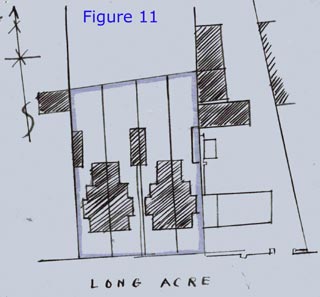
The plan (figure 11) attached to this conveyance shows the shape of the houses and also that the land sold to Brown seems not to extend over the whole leased plot. The Northern boundary for the four houses on this plan does not extend in line with the northern boundary for number 17 whereas it did on the 1885 lease plan for all the plots including no 17.
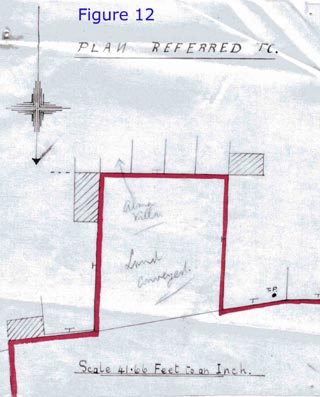
The boundary problem is resolved in a section of the document headed ‘As to the remainder of the property’ and accompanied by another plan (figure 12). This shows that a part of the gardens of the four houses was added to a larger plot, which stretched to Newgate Street, sold by the Earl on the same day to Robert William Pett, of Bingham, retired hat manufacturer for £500.
The whole of that plot was described as
All that piece or parcel of land then used as allotment gardens … having frontages to Newgate Street and Fairfield Street and containing an area of 10764 sq yards
Also those three cottages or buildings erected on the said piece of land or parts thereof
As with other sales of freehold in 1920, the Earl reserved the mineral rights.
This plot is now mostly occupied by the modern car park.
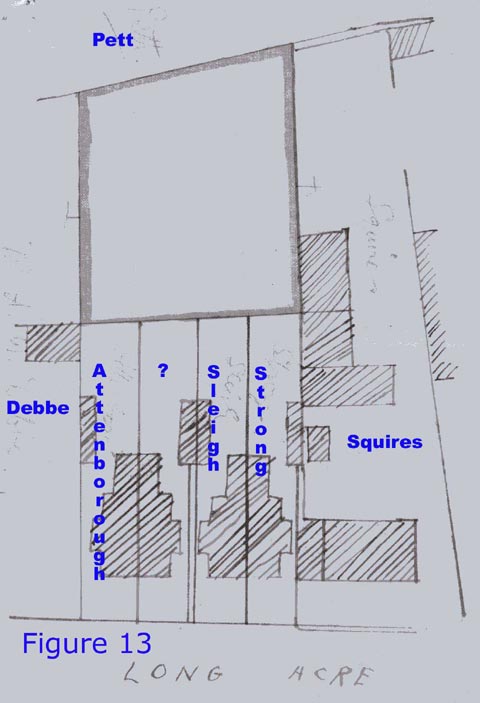
On the 25th October 1920 Brown purchased the land to the rear of the four houses sold by the Earl to RW Pett from him - and that plan (figure 13) also shows where some of the tenants of the houses were. This took the northern boundary of the plot in line with the boundaries of the other houses in the group, which had presumably been extended with a rented piece in the manner of the agreement for Cambridge House. Brown paid Pett £50-0-0.
On 6th November 1920 Edwin Brown sold number 15 to Mrs Eliza Ann Strong, widow of Long Acre Bingham - his sitting tenant - for £375. The conveyance also reveals that next door, number 11, was contracted to be sold to George Sleigh - also a sitting tenant. The conveyance restored appropriate portions of the plot purchased from Pett to each property. The whole transaction - now of course legally being for two pieces of land has another plan (figure 14) attached. Mrs Strong covenanted to build and maintain a fence to the western boundary - but then the document says all walls and fences between the two properties are party walls to be maintained jointly. It also says that the pump and soft water cistern now serving the property hereby conveyed (i.e. no 15) and the adjoining property on the west side shall be used jointly by the owners - but it does not say on which of the properties the pump and cistern are located!
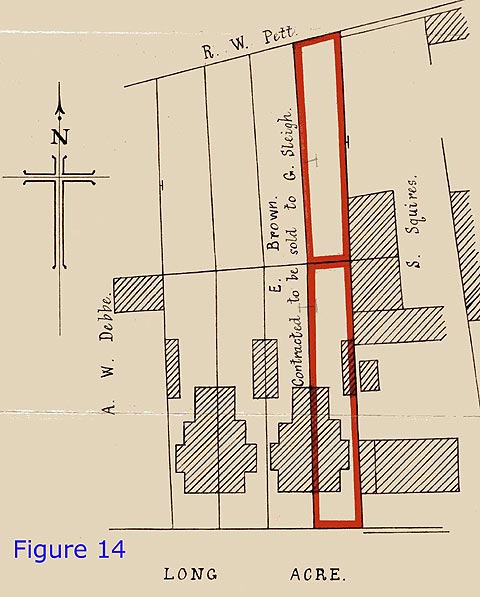
On 22nd November 1920 Eliza borrowed £200 at 5% pa from her son Frederick, a Railway Clerk, of Long Acre by way of a statutory mortgage. (He appears as a witness to a document for The Gables.
The mortgage document carries an endorsement certifying full repayment on 9th May 1927. By this time Frederick was described as ‘now of Porchester Villas’, Long Acre (the Official Search shows him to have been at No8 PV and of Alma Villa!). Interestingly the endorsement is signed 11 April 1935, eight years after repayment!
On both the conveyance and mortgage, Eliza’s signature was witnessed by G A Attenborough of Long Acre; he lived at number 7).
Eliza had made her sons Frederick and Frank executors of her will on 17th June 1927 and died on 4th January 1935. By a conveyance of 12th April 1935 Frank Strong, Newgate Street, Bingham, Threshing Machine Proprietor (he seems to have inherited the business), and Frederick Strong, Railway Clerk, of Alma Villa, sold Number 17, described for the first timed as Alma Villa, to George Arthur Attenborough of Nottingham Road, railway canvasser for £320.
On 16th July 1940 Attenborough sold Alma Villa back to Frederick, who still lived there, for £320 (i.e. no increase). Quite what the story of this was we shall probably never know!
In 1965 Frederick Strong sold Alma Villa to John Adrian Pugh of Arboretum Street Nottingham and Gwendoline Mary Adamson Pugh his wife for £2000. In 1967 Mr and Mrs Pugh moved to Wales and sold Alma Villa to John Oliver Smith of Carlton for £2100. In 1972 Smith, noted as living in Alma Villa, sold to Trevor Alfred Fitchett of Awsworth for £4950. In 1978 Fitchett sold to David Shaw and Eileen Fiona Crosby, both of Nuthall Road Nottingham, for £10600. The house was sold again in 1988, then 1998 and again recently (post 2000) to the present owners.
17 Long Acre
We know from the plan and from other sources that this house was occupied by Stephen Squires, who was a monumental mason and is recorded in directories as being in Long Acre from 1889. It is likely the building shown in green was his workshop at first, but this building had disappeared by the time of the 1910 map. Seven headstones in the churchyard carry the name Squires (of) Bingham and a date before 1884. The earliest of these is 1872, so it may be that he had moved into the workshop before his house was built. He was recorded as living in Cropwell Bishop in the 1881 census. Having been a monumental mason’s premises from the outset number 17 then became a funeral director’s and still is in 2022.
